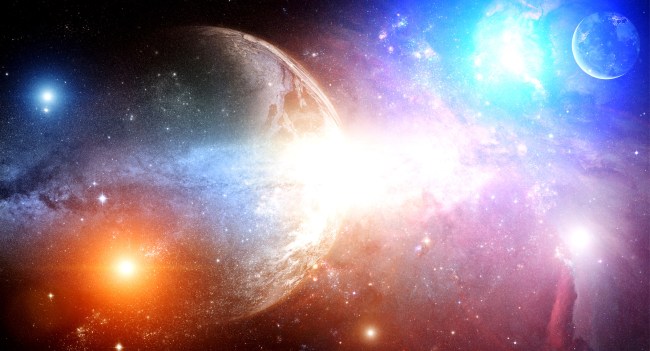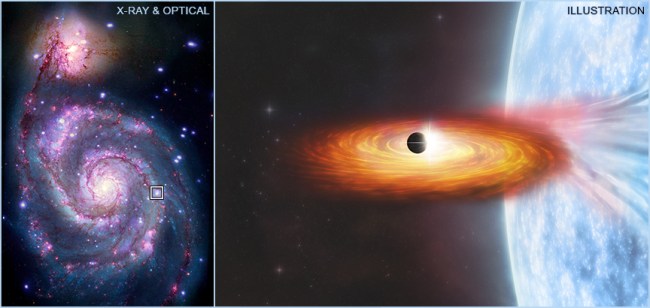
iStockphoto
- Astronomers believe they may have found evidence of the first alien planet orbiting a star outside of the Milky Way.
- The discovery of the Saturn-sized planet was made using NASA’s super powerful Chandra X-Ray Observatory telescope.
- More space news here.
Astronomers utilizing NASA’s Chandra X-Ray Observatory telescope believe they have discovered for the first time evidence of an alien planet located outside of our galaxy.
The Chandra X-Ray Observatory telescope was launched from the Space Shuttle Columbia on July 23, 1999 and allows scientists to make observations normally blocked by the Earth’s atmosphere.
This potential alien planet was located approximately 28 million light years away from the Milky Way in the Messier 51 or “Whirlpool” galaxy. This would put the planet thousands of times farther away than those in the Milky Way.

X-ray: NASA/CXC/SAO/R. DiStefano, et al.; Optical: NASA/ESA/STScI/Grendler; Illustration: NASA/CXC/M. Weiss
Related: Scientists Warn Against Contacting Alien Life, Say It Could End All Life On Earth
“We are trying to open up a whole new arena for finding other worlds by searching for planet candidates at X-ray wavelengths, a strategy that makes it possible to discover them in other galaxies,” said Rosanne Di Stefano of the Center for Astrophysics | Harvard & Smithsonian (CfA) in Cambridge, Massachusetts, who led the study, which was published today in Nature Astronomy.
Astronomers using both ground-based and space-based telescopes — like those on NASA’s Kepler and TESS missions — have searched for dips in optical light, electromagnetic radiation humans can see, enabling the discovery of thousands of planets.
Di Stefano and colleagues have instead searched for dips in the brightness of X-rays received from X-ray bright binaries. These luminous systems typically contain a neutron star or black hole pulling in gas from a closely orbiting companion star. The material near the neutron star or black hole becomes superheated and glows in X-rays.
Because the region producing bright X-rays is small, a planet passing in front of it could block most or all of the X-rays, making the transit easier to spot because the X-rays can completely disappear. This could allow exoplanets to be detected at much greater distances than current optical light transit studies, which must be able to detect tiny decreases in light because the planet only blocks a tiny fraction of the star.
The team used this method to detect the exoplanet candidate in a binary system called M51-ULS-1, located in M51. This binary system contains a black hole or neutron star orbiting a companion star with a mass about 20 times that of the Sun. The X-ray transit they found using Chandra data lasted about three hours, during which the X-ray emission decreased to zero. Based on this and other information, the researchers estimate the exoplanet candidate in M51-ULS-1 would be roughly the size of Saturn, and orbit the neutron star or black hole at about twice the distance of Saturn from the Sun.
Related: NASA Reveals What Galaxies And Supermassive Black Holes ‘Sound Like’
“Unfortunately to confirm that we’re seeing a planet we would likely have to wait decades to see another transit,” said co-author Nia Imara of the University of California at Santa Cruz. “And because of the uncertainties about how long it takes to orbit, we wouldn’t know exactly when to look.”
The researchers added, “If a planet exists in this system, it likely had a tumultuous history and violent past. An exoplanet in the system would have had to survive a supernova explosion that created the neutron star or black hole. The future may also be dangerous. At some point the companion star could also explode as a supernova and blast the planet once again with extremely high levels of radiation.”
Study co-author Julia Berndtsson of Princeton University understands there will be skeptics of their possible discovery of an alien planet.
“We know we are making an exciting and bold claim so we expect that other astronomers will look at it very carefully. We think we have a strong argument, and this process is how science works,” she said.